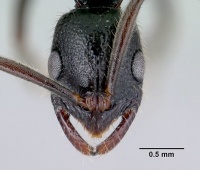Leptogenys ralipra
| Leptogenys ralipra | |
|---|---|

| |
| Scientific classification | |
| Kingdom: | Animalia |
| Phylum: | Arthropoda |
| Class: | Insecta |
| Order: | Hymenoptera |
| Family: | Formicidae |
| Subfamily: | Ponerinae |
| Tribe: | Ponerini |
| Genus: | Leptogenys |
| Species group: | saussurei |
| Species: | L. ralipra |
| Binomial name | |
| Leptogenys ralipra Rakotonirina & Fisher, 2014 | |
Leptogenys ralipra is restricted to the montane rainforest of east-central Madagascar. It has been collected only from the Moramanga region. Worker specimens of L. ralipra have been found foraging in leaf litter and nesting in rotten logs and rotten sticks on the ground.
Identification
A member of the saussurei species group. Rakotonirina and Fisher (2014) - Worker. Mandible short and robust, capable of closing tightly against clypeus; anterior clypeal margin medially projecting into triangular lobe; clypeus with sharp edge or lamella. Eye large, maximum diameter larger than maximum width of antennal scape. Dorsum of head and mesosoma distinctly sculptured; with mesosoma in dorsal view, metanotal groove indistinct. In dorsal view, posterior margin of petiolar node noticeably excised medially. Apical margin of mandible with one apical tooth and only one preapical tooth. Mandible smooth and shiny between scattered punctures; head densely punctulate to punctate; smaller species.
Leptogenys ralipra can be recognized by the absence of a metanotal groove, the excised posterior border of the petiolar node, and particularly by its smaller size and smooth and shiny mandible. In Leptogenys ambo, the posterior margin of the petiolar node is not medially excised. The apical margin of the mandibles is armed with three teeth in Leptogenys vatovavy. The longitudinally striate mandibles, longitudinally rugulose head, densely punctate superimposed with transverse rugulae of dorsum of pronotum and mesonotum and the larger species (HW: 1.77, HL: 2.29, PW: 1.45) of L. andritantely distinguishes it from L. ralipra.
Keys including this Species
Distribution
Latitudinal Distribution Pattern
Latitudinal Range: -18.8707° to -18.8707°.
| North Temperate |
North Subtropical |
Tropical | South Subtropical |
South Temperate |
- Source: AntMaps
Distribution based on Regional Taxon Lists
Malagasy Region: Madagascar (type locality).
Distribution based on AntMaps
Distribution based on AntWeb specimens
Check data from AntWeb
Countries Occupied
| Number of countries occupied by this species based on AntWiki Regional Taxon Lists. In general, fewer countries occupied indicates a narrower range, while more countries indicates a more widespread species. |

|
Estimated Abundance
| Relative abundance based on number of AntMaps records per species (this species within the purple bar). Fewer records (to the left) indicates a less abundant/encountered species while more records (to the right) indicates more abundant/encountered species. |

|
Biology
|
Castes
Nomenclature
The following information is derived from Barry Bolton's Online Catalogue of the Ants of the World.
- ralipra. Leptogenys ralipra Rakotonirina & Fisher, 2014: 123, figs. 2B, 38B, 39B, 140, 147 (w.) MADAGASCAR.
Unless otherwise noted the text for the remainder of this section is reported from the publication that includes the original description.
Description
Worker
(7 specimens). HW: 0.98–1.04, HL: 1.34–1.44, CI: 71–73, SL: 1.16–1.25, SI: 118–120, PW: 0.85–0.94, WL: 1.99–2.22, PNH: 0.84–0.90, PNL: 0.72–0.80, PNW: 0.75–0.81, DNI: 101–108, LNI: 112–119.
Head not broadened anteriorly, lateral border broadly convex with greatest width at level of eyes. Anteromedian lobe of clypeus ending apically with two denticles or tubercles; lateral margin bordered with rippled subopaque lamella. Mandible with one apical and one preapical tooth. With mesosoma in dorsal view, metanotal groove indistinct; in profile, mesopleural sulcus not visible, but upper portion with wide, shallow impression at level of metathoracic spiracle. Petiolar node elongate in dorsal view, posterior margin medially excised. Mandible generally smooth between coarse punctures. In full-face view, dorsum of head in front of level of anterior margin of eye finely and densely reticulate-rugose with scattered, large punctures. Sculptures between anterior and posterior margin of eyes rugose, superimposed with punctures; behind level of posterior margin of eye, punctures become larger and widely scattered toward posterior border of head. Dorsum of mesosoma and petiolar node sparsely punctate. With mesosoma in profile, mesopleuron and lower half of propodeum mostly smooth; upper half of propodeum and sides of node with reticulate-rugulose sculpture, intermingled with sparse punctures. Gaster generally smooth apart from scattered, small piligerous punctures.
Type Material
Holotype worker: Madagascar, Toamasina, Torotorofotsy, -18.8707, 48.3474, 1070 m, montane rainforest, marsh edge, ex rotten log, 29 Mar 2004 (Malagasy ant team) collection code: BLF10717, specimen code: CASENT0051142 (California Academy of Sciences). Paratypes: 2 workers, same data as holotype but specimen coded as: CASENT0196893, CASENT0247274 (CASC, The Natural History Museum).
References
- Rakotonirina, J.C. & Fisher, B.L. 2014. Revision of the Malagasy ponerine ants of the genus Leptogenys Roger (Hymenoptera: Formicidae). Zootaxa 3836, 1-163.
References based on Global Ant Biodiversity Informatics
- Rakotonirina J. C., and B. L. Fisher. 2014. Revision of the Malagasy ponerine ants of the genus Leptogenys Roger (Hymenoptera: Formicidae). Zootaxa 3836 (1): 001163.


